ASRock Core 100HT-BD : Bringing HTPCs to the Mainstream Market [UPDATED : Noise Issue]
by Ganesh T S on July 19, 2010 9:34 PM EST- Posted in
- Home Theater
- Arrandale
- ASRock
- Media Streamer
- Core i3
- HTPC
One of the most interesting aspects of the Arrandale platform is the fact that the GPU is integrated in the same package as the CPU. The GPU die also contains the PCIe and DDR3 memory controller. While the main CPU is fabricated in the 32nm process, the GPU die is fabricated in the 45nm process. Placing the GPU and CPU in the same package saves on power and also board costs. The graphics part of the GPU die in the package is an evolutionary version of the Intel G45 IGP. A comparison of the Intel HD Graphics in the Arrandales and the earlier G45 is provided below.

An interesting thing to note here is the availability of dynamic frequency scaling for the Arrandale GPU, which actually lowers the power consumption of the system. A 900 MHz GPU part on a typical Clarkdale system would up the TDP by 15W or more compared to the lowest end Clarkdale with a 733 MHz GPU. On the Core 100 HT-BD, however, overclocking doesn't require any special thermal arrangements. The higher frequencies kick in only when the load on the GPU becomes high.
We had earmarked the Clarkdales as the perfect HTPC platforms earlier this year. This Arrandale offering may actually tempt us to revise our opinions, given the form factor and the power profile. We will cover this in detail in the later sections. In the rest of this section, we will cover the features of the Intel HD Graphics engine, as it relates to HTPC users. Before going into the details, let us take a look at what Intel has improved in terms of video decode and processing in this iteration of their IGP.
DXVA Compatibility
Intel's support for DXVA came in for a lot of criticism during the G45 days. The paranoia inside the company made it impossible for open source enthusiasts to get hold of the special DXVA interface used by Intel. It used to be made available under NDA to various ISVs (Independent Software Vendors) such as Cyberlink, ArcSoft etc. Thankfully, things have been slowly changing for the better. Currently, most applications (except for VLC) are able to take advantage of the DXVA acceleration provided by the HD Graphics engine. The screenshot below gives us a quick idea of the DXVA capabilities of the Core i3-330M in the Core 100 HT-BD. It is interesting to observe that there is no VLD mode for VC-1, but we did observe 1080p VC-1 Blu-Rays play with less than 5% CPU usage on ArcSoft TMT. This just indicates that the interface to full acceleration mode for VC-1 is available only under NDA as of now.
HD Audio Bitstreaming
Right from its debut, the Arrandales have been able to bitstream HD audio from Blu-Ray discs played back through Cyberlink's PowerDVD or ArcSoft TMT. The Core 100 HT-BD is no different. We were able to play back all Blu-Rays with bitstreaming to the AV receiver, as the following screenshots show. In addition, hardware acceleration with Intel HD Graphics shows its class, with low CPU utilization being observed during playback. Despite the red spikes observed in the DPC Latency Checker program, we didn't notice any audio dropouts or stutters in the video.
Using the open source ffdshow Audio Decoder, HD audio can also be bitstreamed out of standalone MKVs and M2TS files. (More on this in the next section)
With the above features, Intel HD Graphics seems to be a winner, and the Core 100 HT-BD could potentially be the utopian HTPC that enthusiasts have been searching for. Is that really the case?
Driver Support - Intel Misses the Boat!
Since the release of the G45, videophiles have been clamouring for the support of 23.976 fps display refresh rate. Intel caved in and released a driver where you could choose 23 Hz in the graphics control panel. Unfortunately, this only results in a refresh rate of 24 fps. While watching videos encoded at 23.976 fps, this results in a small stutter every 40 seconds or so. Most people get past this by setting the refresh rate of their display to 60 Hz. However, dedicated enthusiasts still see this as a major shortcoming of the platform.
Another issue which has remained since the G45 days is the efforts taken to open up the DXVA specifications of the GPU for open source developers. Lot of progress has been made over the years, but full VC-1 decode acceleration remains elusive in applications like MPC-HC or VLC. As we discussed in the DXVA Compatibility subsection, the VC1_VLD mode which is commonly utilized by open source video decoders is absent. However, Intel's marketing team does indicate complete VC-1 decode acceleration. We can only surmise that this is made available for the Microsoft and other ISV decoders to make use of.
The drivers supposedly support advanced deinterlacing, but users do not have as much control over the algorithms used as they have when using ATI HTPC cards such as the Radeon 5xxx series. Noise reduction algorithms are also not transparent to the users. The frequency of driver updates is rather low, and issues continue to remain unaddressed.
If the end user can put up with these iGPU limitations (personally, I can), the Core 100 HT-BD is indeed a very good choice. This will be further elaborated in the next few sections.


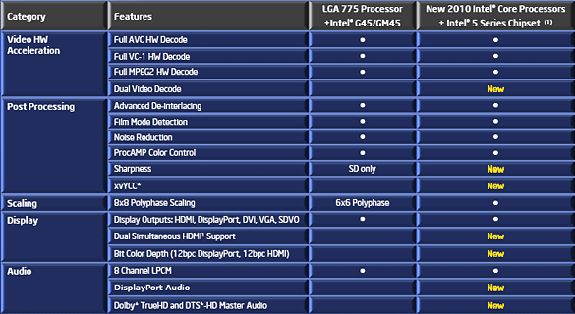
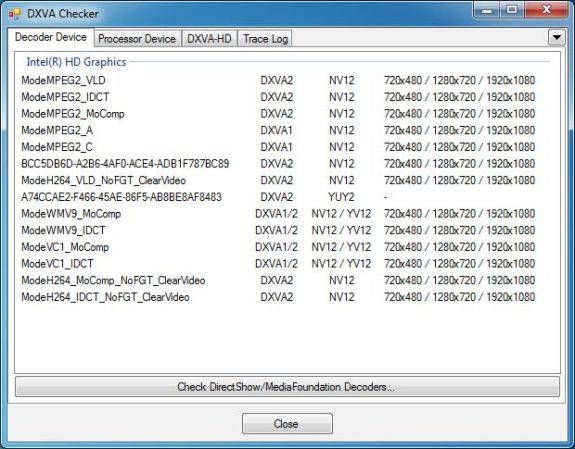
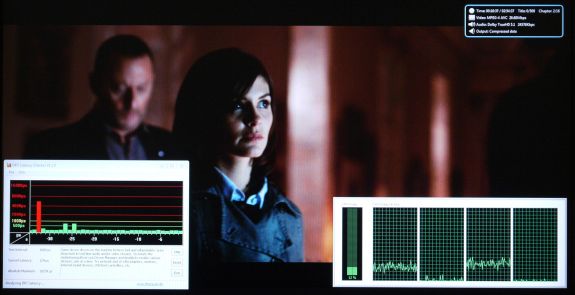
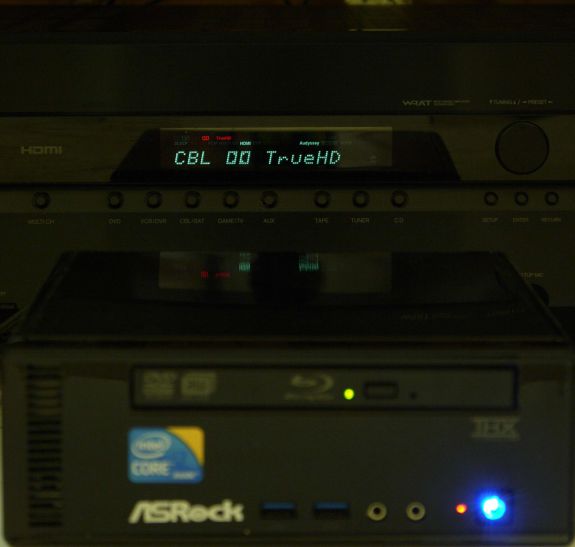
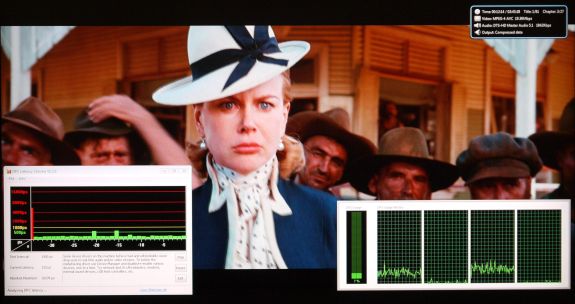
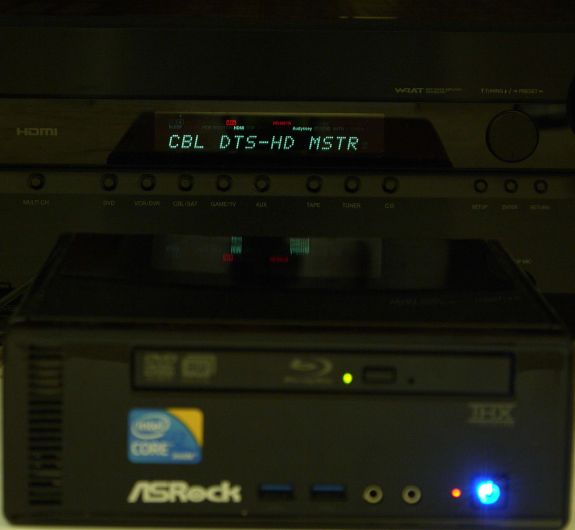








107 Comments
View All Comments
spddemon - Thursday, July 22, 2010 - link
That is great news ganeshts.34.5db at 2ft is very quiet to me... with my theater setup you can not even hear my xbox so this would be no problem.
i still want to see the core i3 330 vs 530 tests. I wonder how much faster the 530 is since it is a faster CPU and GPU, but I also wonder how much more power it will consume in typical home theater use.
omems - Thursday, July 22, 2010 - link
This is a really great article, Ganesh. My HTPC is getting a bit old at about 6 years, so I'm definitely ready to upgrade and take advantage of some of the newer technologies which are finally being combined usefully. I have a few questions about how this assembly sleeps:1. When you put it to sleep, which components remain on? Just RAM? Any fans?
2. I believe the Atheros AR9287 supports what they call wake-on-wireless. Does that work in this implementation, from sleep? How about from hibernation?
3. Did you try coming out of Hibernation and seeing if the handshakes were maintained?
4. I am confused by what's going on when you say in the Ease of Use section:
"...ASRock supplies an Instant Boot utility. Using this, whenver [sic] the Core 100 HT-BD is shut down, it boots up once again and shuts down before the power can be safely removed."
Does the instant boot utility bring the machine into the main OS (say Windows) or is it a stripped-down linux environment for simple access to things like music and DVD playback?
If it's the former, what's the point--what does it do that just waking up doesn't? Or is it some kind of middleware to keep maybe the IR and WiFi active?
If it's the latter, what sorts of playback support is there?
I'm mostly concerned with limiting hard drive and power usage, but also being able to quickly resume from a wireless connection. With my current setup (almost 7 years old at its core), I like to send it to Hibernate, and then wake it up via WOL with my iPod or another computer to send new files to over. I avoid sleep because the something (CPU fan and hard drives, if I recall correctly) is still active and it's kind of loud and I worry the drives will wear out faster. I probably could sort it out but why bother when such cool new toys are coming out?
Thanks!
ganeshts - Thursday, July 22, 2010 - link
omems,I will try to handle your queries in a series of replies. In this one, I will let you know things which I know off the top of my head without accessing the unit:
1. Sleep : The fans are completely off. I heard nary a sound from the unit when in sleep mode. I think cross ventilation slots on either side of the RAM modules help. The blue front LED keeps blinking slowly on and off in sleep mode, but you can turn that OFF in the BIOS by Enabling the 'Goodnight LED' option (see BIOS pictures set).
2. Wake on wireless using AR9287 hasn't been tested. I will get back to you on this ASAP.
3. Handshakes are maintained much better than in my ATI based HTPC. My power on sequence when unit is in sleep or hibernate or complete shutdown mode (as long as AC adapater is connected to unit) is as follows: Power on TV and put it it in AV receiver input mode -> Power on Receiver -> Press Power button on MCE remote. Display comes out perfectly on TV every time I followed this sequence.
4. InstantBoot : Look at the coverage on ZDNet here: http://www.zdnet.com/blog/hardware/asrock-4-second... ; I think their explanation and analysis would be much better than what I can do in this space :)
Will provide more info within a day or so.
ganeshts - Thursday, July 22, 2010 - link
omems,ASRock reports that only the AR9280 and AR9281 support Wake-On-Wireless. Unfortunately, the add on card in Core 100 is the AR9287.
I am not sure how you wanted to use the 'wake on wireless' feature, but I would say that using the MCE remote to wake up the unit is the easiest and most simple.
omems - Monday, July 26, 2010 - link
Thanks, Ganesh, for all the additional info.I plan to use the wake on wireless when the HTPC is asleep and I'm at another computer in the house and want to move newly-acquired media to the HTPC without having to go to that room and wake it up.
I suppose it's not a deal breaker though if the included card doesn't support it. I could use encouragement to get off my butt now and again.
The insantBoot sounds like an interesting hybrid concept. Thanks for the link.
Cheers
ganeshts - Monday, July 26, 2010 - link
omems, I did see an option in the BIOS to enable / disable 'Wake-On-LAN'. So, if this unit is going to be connected to a wired network, you might still find it hard to get off your couch / chair / bed :Dvlado08 - Thursday, July 22, 2010 - link
Ganesh on page 5 you say:"We did observe red spikes, but disabling the C-states, as well as SpeedStep in the BIOS Advanced CPU configuration helped in alleviating the issue."
On page 11 you say:
"At idle, the system consumed around 18 W."
1) Is this DC power or is this AC power measured at wall outlet?
2) Is 18W idle power with enabled C-states and SpeedStep?
3) And if yes then what is the idle power when disabling the C-states, as well as SpeedStep?
ganeshts - Thursday, July 22, 2010 - link
vlad08,The quoted power numbers are measured AC power using Kill-a-Watt over a 6 hour usage period.
18W idle power is with C-state and SpeedStep enabled. I will quote idle power numbers with them disabled after testing out tonight.
ganeshts - Friday, July 23, 2010 - link
vlado08,The idle power consumption with both C-states and SpeedStep disabled is 21.6W.
The CPU wasn't overclocked (it idled at 2.14 GHz).
Regards
Ganesh
vlado08 - Friday, July 23, 2010 - link
Thanks Ganesh.So it is still less than the ion 330 idle power - 28,6W according to:
http://www.anandtech.com/show/2828/8
If only Intel team resolve the 23,976hz issue .....
I am still waiting because for me this is more important than bitsreaming